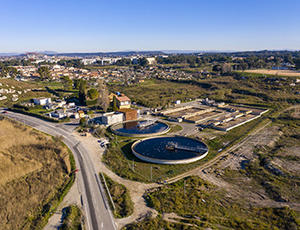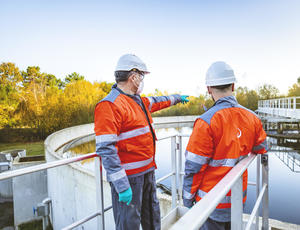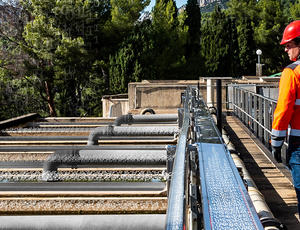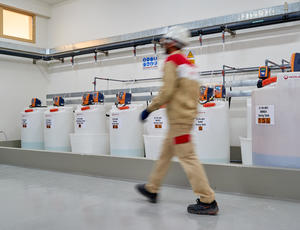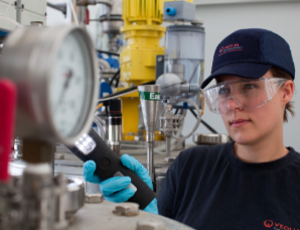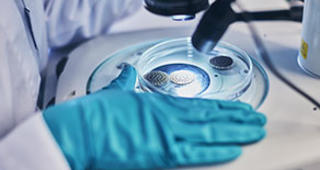Highly compact and innovative modular flotation units to achieve the highest removal efficiency on suspended solids, oils and grease, and insoluble chemical oxygen demand (COD).
Overview
Flotation is a physical process which consists of blowing fine air bubbles into a water tank to be purified by achieving solid/liquid separation. This process reduces the density of particles that float instead of sinking.
The type of flotation used by Idraflot is dissolved air flotation (DAF), in which the suspension is saturated with air at high pressure. The bubbles in a DAF system are much smaller than in other types of flotation systems thus adhering better to solids. This allows Idraflot DAFs to achieve high thickening and clarification grades that can be defined as ultra flotation.
Designed for treatment capacities ranging from 5 to 480 m3/h, Idraflot flotation units are protected by three patents intended to assure a perfect mixing of the waste with saturated water and an uniform distribution of the water flow along the entire surface of the unit. Moreover, the Idraflot tank is designed with modular components, allowing for easy replication of the same level of performance throughout the entire unit. This modular design not only enhances process stability but also allows air blowing across the entire surface of the unit rather than from only one point as in traditional systems, enabling a significant advancement in functionality.
Finally, the corrosion resistance of the Idraflot is a fundamental characteristic, particularly crucial when dealing with highly concentrated liquids. To ensure robust protection against corrosion, Idraflot flotation units are made of austenitic stainless steel.
How Idraflot works
The first step consists of mixing the wastewater with chemicals. Coagulants and flocculants are injected to improve the solid/liquid separation. Depending on the water to be treated, Idraflot offers the advantage of optimizing the dosage of chemicals compared to traditional flotation processes.
The wastewater subsequently enters the DAF double tank where patented nozzles blow fine air bubbles under a pressure of 6 bar. This process facilitates the flotation of solids that are more similar to the air, helping them rise and accumulate at the surface, while the clarified water flows down to the second tank. The accumulated solids, also called floated sludge, are then separated from the water using a scraper for further processing within the sludge train.

Features and benefits

A unique mobile and modular stainless steel design for faster delivery, easier implementation and reduced costs.

Extremely compact footprint — 35 to 40% smaller than traditional flotation units.

Reduced chemical additive dosing.

Optimized saturated water flow rate.

Enhanced thickening and clarification performance.

Avoid hydraulic short circuits.
Applications
Services
Satisfying your needs is also made possible with our digital services that make your water treatment processes smarter, safer and more sustainable.
Resources & Product range
IDRAFLOT IFS Series video
Idraflot SPF - Highly compact DAF units using a revolutionary patented system which combines nozzles to mixers for the production of whitewater (water saturated with air microbubbles).
Idraflot IFS - Innovative flotation units with low chemical consumption having a modular structure able to keep performance at the same stable level along the whole length of the machine.
Contact
Idraflot is the right technology when clarification and pollution load reduction are required. Moreover, it is the ideal solution when a limited footprint is available.

Cristina Del Piccolo
Chief Technical Officer - Veolia water Technologies Italy
Contact Cristina through her LinkedIn account
FAQ about Idraflot™
What is Dissolved air flotation (DAF)?
Dissolved air flotation is a proven and effective technology for the physical and chemical separation of solids and liquids. The method is ideal for removing lightweight particles that float and remain suspended in wastewater streams, such as suspended solids (SS), oils and grease, and insoluble chemical oxygen demand (COD). The DAF process consists of blowing fine air bubbles into the wastewater at elevated pressures. These bubbles attach themselves to the solids, causing them to float to the surface of the water where they can be removed by a scraper device.
Why is DAF more efficient than traditional flotation?
Compared to traditional flotation units, DAF units require lower dosage of chemicals (coagulant and flocculant) while achieving significantly higher efficiency in solid/liquid separation. This improved efficiency is achieved through the injection of fine air bubbles at high pressure into the water tank, which results in a much faster ascent rate for the solid components. In fact, the rising rate in a DAF unit can be two times higher than that of traditional flotation units.
In which industry sectors are DAFs most used?
Dissolved Air Flotation is well established for water and wastewater treatment in food and beverage, pulp and paper and also municipal markets.
Case Studies

Milk processing and dairy products
Idraflot, the ideal solution for the pretreatment of suspended solids and the reduction of chemical oxygen demand in the treatment of wastewater from an Italian dairy processing and production cooperative.

Meat processing with specialization in the salami sector
An Italian agricultural cooperative specializing in the production of deli meats uses Idraflot to reduce the concentration of suspended solids and the chemical oxygen demand in its wastewater before the discharge.

Waste paper recycling for corrugated paper production.
The leading Turkish paper producer relies on Idraflot technology for the separation of suspended solids in wastewater.



